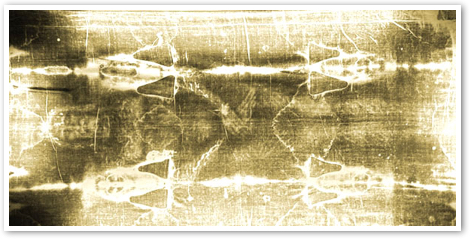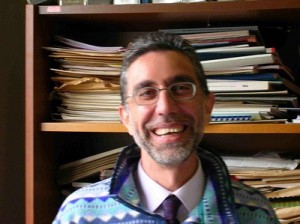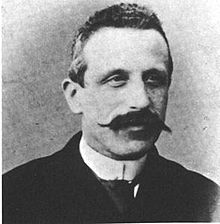The Shroud of Turin: Evidence for Everything?
- FATHER DWIGHT LONGENECKER
Those who ask for evidence for the existence of God should take the time to examine the Shroud of Turin.

In June I had the joy to spend a week in Italy. One reason for my pilgrimage was to venerate the Shroud of Turin. I had been intrigued by the supposed burial cloth of Christ since I was in college, and as I was in England leading a pilgrimage with Joseph Pearce, I did not want to miss the chance of traveling to Turin to see the shroud.
I was not disappointed. After taking the high-speed train from Rome, a decent restaurant and an overnight stay, we walked the few blocks from our hotel first thing in the morning to the Cathedral of St. John the Baptist. We hustled, crowd free down the pathways set up to accommodate the tens of thousands of pilgrims from around the world who would, like us, have a few minutes to stand in silence before the famous, mysterious linen winding sheet of Christ.
After my visit I am more convinced than ever not only that the Shroud of Turin is the burial cloth of Christ, but that the mysterious image was produced by a blast of radiance from the resurrection. Those who wish to research the shroud can find scholarly and popular articles here and here. The most interesting thing about the shroud is the more scientific research is done the more the claims to authenticity accumulate. Not only is the image on the shroud that of a crucified man, but a particular crucified man.
He wore a crown of thorns. His legs were not broken. His face was punched. His side was pierced in a way consistent with a Roman spear. His back shows the marks of a severe flogging consistent with the flagellum used by the Romans. In other words, all the wounds match those not just of any crucified man, but those unique to Jesus of Nazareth.
Other details match in an extraordinary way. Fabric experts acknowledge that the particular linen cloth matches that used in the first century by wealthy individuals. The chemical traces on the cloth match the herbs and spices that were known to be used for Jewish burials in Roman times. Pollen from the shroud matches that present in Jerusalem in the first century. New scientific dating techniques counter the 1988 carbon 14 dating which identified a medieval date and they date the shroud to the first century.
Most mysterious is the image itself. In 1978 a team of American researchers were finally given access to the shroud. They ran a whole series of tests covering the range of scientific disciplines. Their analyses found no sign of artificial pigments and they concluded, "The Shroud image is that of a real human form of a scourged, crucified man. It is not the product of an artist." What formed the image? The scientists were stumped and admitted that "no combination of physical, chemical, biological or medical circumstances" could adequately account for the image.
 Paolo Di Lazzaro
Paolo Di LazzaroSo what formed the image? The best description is that it is an extremely delicate singe marking. Italian physicist Paolo Di Lazzaro concedes in an article for National Geographic that every scientific attempt to replicate it in a lab has failed. "Its precise hue is highly unusual, and the color’s penetration into the fabric is extremely thin, less than 0.7 micrometers (0.000028 inches), one-thirtieth the diameter of an individual fiber in a single 200-fiber linen thread."
Di Lazzaro and his colleagues at Italy’s National Agency for New Technologies, Energy and Sustainable Economic Development (ENEA) experimented for five years, using modern excimer lasers to train short bursts of ultraviolet light on raw linen, in an effort to simulate the image’s coloration.
They came tantalizingly close to replicating the image’s distinctive color on a few square centimeters of fabric. However, they were unable to match all the physical and chemical characteristics of the shroud image, and reproducing a whole human figure was far beyond them. De Lazzaro explained that the ultraviolet light necessary to reproduce the image of the crucified man "exceeds the maximum power released by all ultraviolet light sources available today." The time for such a burst would be shorter than one forty-billionth of a second, and the intensity of the ultra violet light would have to be around several billion watts."
The scientists shrug and say the only explanation lies beyond the realm of twenty-first century technoscience. In other words, the extraordinary burst of ultra violet light is not only beyond the ability and technology of a medieval forger. It is beyond the ability and technology of the best twenty-first century scientists.
Consequently, I wrote an essay some time ago asking atheists who insist on "evidence for the existence of God" why they did not take time to study the Shroud of Turin. I suggested that if God did not exist, then the natural world had to be a closed system. If, however, just one miracle could be proven to have happened, then nature is not a closed system. If that miracle was intelligible then there had to be an intelligent force outside the system that was greater than the system. The resurrection of Jesus Christ would be that one necessary miracle. It is, after all, the miracle of miracles.
 Secondo Pia
Secondo PiaIt is therefore ironic that it is only in this modern technoscientific age that the mysterious qualities of the Shroud of Turin have been unlocked. Ever since the photographer Secondo Pia discovered the shroud’s negative image in 1898 the forensic, archeological, documentary, cultural, chemical, physiological and physical evidence has accumulated. If there were ever any hard evidence for a miracle, this is it.
Therefore those who ask for evidence for the existence of God should take the time to examine the Shroud of Turin. The atheists who I conversed with dismissed such an idea scornfully. Should they ever be unbiased enough to explore the relic objectively. What they find may at least budge them from their atheism into agnosticism, and from there it is only a short hop to believing in everything.
 This is J. Fraser Field, Founder of CERC. I hope you appreciated this piece. We curate these articles especially for believers like you.
This is J. Fraser Field, Founder of CERC. I hope you appreciated this piece. We curate these articles especially for believers like you.
Please show your appreciation by making a $3 donation. CERC is entirely reader supported.

Acknowledgement
 Father Dwight Longenecker. "The Shroud of Turin: Evidence for Everything?." The Imaginative Conservative (August, 2015).
Father Dwight Longenecker. "The Shroud of Turin: Evidence for Everything?." The Imaginative Conservative (August, 2015).
Reprinted with permission from The Imaginative Conservative. See the original article here.
The Imaginative Conservative, we hope, offers to our families, our communities, and the Republic, a conservatism of hope, grace, charity, gratitude and prayer.
The Author
 Father Dwight Longenecker serves as the pastor of Our Lady of the Rosary parish in Greenville, South Carolina. Father Longenecker studied for the Anglican ministry at Wycliffe Hall, Oxford and served for ten years in the Anglican ministry as a curate, a chaplain at Cambridge and a country parson. In 1995 he and his family were received into full communion with the Catholic Church. He is the author of more than twenty books including: Beheading Hydra, Praying the Rosary for Inner Healing, Listen My Son: St. Benedict for Fathers, More Christianity, Challenging Catholics: A Catholic Evangelical Dialogue, St. Benedict and St. Therese: The Little Rule & the Little Way, Mary: A Catholic-Evangelical Debate, and The Path to Rome. You can follow his writings, listen to his podcasts, join his online courses, browse his books, and be in touch at DwightLongenecker.com.
Father Dwight Longenecker serves as the pastor of Our Lady of the Rosary parish in Greenville, South Carolina. Father Longenecker studied for the Anglican ministry at Wycliffe Hall, Oxford and served for ten years in the Anglican ministry as a curate, a chaplain at Cambridge and a country parson. In 1995 he and his family were received into full communion with the Catholic Church. He is the author of more than twenty books including: Beheading Hydra, Praying the Rosary for Inner Healing, Listen My Son: St. Benedict for Fathers, More Christianity, Challenging Catholics: A Catholic Evangelical Dialogue, St. Benedict and St. Therese: The Little Rule & the Little Way, Mary: A Catholic-Evangelical Debate, and The Path to Rome. You can follow his writings, listen to his podcasts, join his online courses, browse his books, and be in touch at DwightLongenecker.com.


